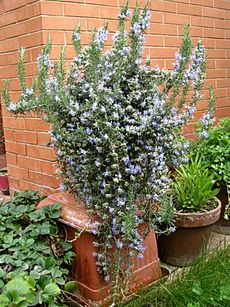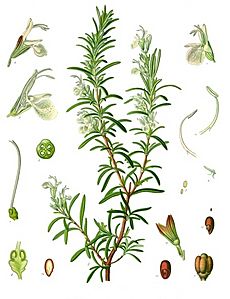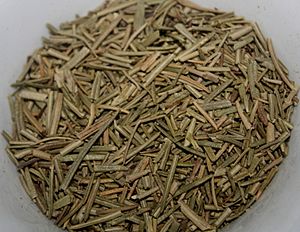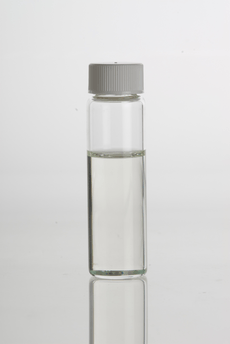Rosemary facts for kids
Quick facts for kids Rosemary |
|
|---|---|
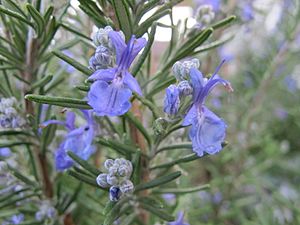 |
|
| Flowering rosemary | |
| Scientific classification | |
| Genus: |
Salvia
|
| Species: |
rosmarinus
|
Rosemary (its scientific name is Salvia rosmarinus) is a woody plant that lives for many years. It's a popular herb with a lovely smell. Its leaves look like needles and stay green all year. Rosemary flowers can be white, pink, purple, or blue. This plant originally comes from the Mediterranean region.
Rosemary is part of the mint family, called Lamiaceae. This family also includes many other herbs you might know. The name "rosemary" comes from a Latin phrase, ros marinus, which means "dew of the sea." Sometimes, people also call it "anthos," an old Greek word for "flower." Rosemary has many small roots that spread out, like a fibrous root system.
Contents
What Rosemary Looks Like
Rosemary is a fragrant, evergreen bush. Its leaves look a bit like the needles of a hemlock tree. It grows naturally in the Mediterranean and Asia. But it can also handle cooler weather quite well. Rosemary is very tough and can survive long periods without much water. In some places, it can even grow too much and become an invasive species, meaning it spreads where it's not wanted.
It can be tricky to grow rosemary from seeds. They don't always sprout easily and grow slowly. However, once a rosemary plant starts growing, it can live for up to 30 years!
Rosemary plants can grow in different ways. Some grow straight up, reaching about 1.5 meters (5 feet) tall. They can sometimes even grow up to 2 meters (6.5 feet). The leaves stay green all year. They are about 2 to 4 centimeters (1 to 1.5 inches) long and 2 to 5 millimeters wide. The top of the leaves is green, and the bottom is white with soft, woolly hairs.
In places with mild weather, rosemary flowers in spring and summer. But in warm climates, it can bloom almost all the time! Its flowers can be white, pink, purple, or deep blue. Sometimes, rosemary even flowers outside its usual season. You might see it bloom in early winter or even in the middle of winter.
The History of Rosemary
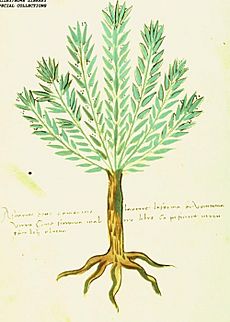
The very first time rosemary was mentioned was on old stone tablets from about 5000 BC. After that, we don't know much until the ancient Greeks and Romans. The Egyptians also used rosemary in their burial ceremonies.
Famous writers like Pliny the Elder (who lived from 23 to 79 AD) wrote about rosemary. Pedanius Dioscorides, a Greek botanist, also wrote about it in his famous book, De Materia Medica. This book was one of the most important books about herbs in history.
Rosemary then traveled east to China. It started growing there naturally around 220 AD, during the late Han dynasty.
We don't know exactly when rosemary first came to England. The Romans might have brought it when they invaded in the first century. But the first clear records of rosemary in Britain are from the 8th century. This was thanks to Charlemagne, a powerful king who encouraged people to grow herbs. He ordered rosemary to be planted in monastery gardens and on farms.
Rosemary didn't become widely grown in Britain until 1338. That year, Joan of Valois, Countess of Hainaut sent some rosemary cuttings to Queen Philippa. Queen Philippa was married to King Edward III. The gift came with a letter that talked about how useful rosemary and other herbs were. You can still see this old letter in the British Museum. The rosemary was planted in the garden of the old palace of Westminster. After this, rosemary appeared in most English herb books. It became very popular for cooking and for medicine.
Rosemary finally arrived in the Americas with early European settlers in the early 1600s. From there, it quickly spread to South America and around the world.
How Rosemary Is Used
When rosemary is grown, its leaves, small branches, and flowers are collected. People use rosemary as a pretty plant in gardens. It can also help keep some pests away. The leaves are used to add flavor to many foods. You might find it in stuffing or with roasted meats.
Growing Rosemary
Rosemary is a beautiful plant that doesn't need much water. Because of this, it's often used in gardens. It's especially popular in places with a Mediterranean climate, where summers are dry. It's considered easy to grow and usually doesn't get many pests.
Rosemary can grow quite large and stay attractive for many years. You can trim it into neat shapes or use it to make low hedges. It's also easy to grow in pots. Some types of rosemary spread out low to the ground, making a thick, strong cover.
Rosemary grows best in soil that drains water well and is open to the sun. It doesn't like to sit in soggy water. Some types can be harmed by frost. It grows best in soil that is neutral to slightly alkaline (pH 7–7.8) and has average nutrients. You can grow a new rosemary plant from an existing one. Just cut a fresh shoot about 10 to 15 centimeters (4 to 6 inches) long. Remove a few leaves from the bottom and plant it directly into the soil.
Types of Rosemary (Cultivars)
Many different types of rosemary, called cultivars, have been chosen for gardens. Here are a few examples:
- 'Albus' – This type has white flowers.
- 'Arp' – Its leaves are light green and smell like lemon. It's also very good at handling cold weather.
- 'Miss Jessop's Upright' – This type grows tall and straight, with wider leaves.
- 'Prostratus' – This type grows low to the ground, like a groundcover.
- 'Tuscan Blue' – This is a strong type that grows upright, like the traditional rosemary plant.
Some of these types have won awards, like the Royal Horticultural Society's Award of Garden Merit. These include 'Miss Jessop's Upright', 'Severn Sea', 'Sissinghurst Blue', and 'Benenden Blue'.
Rosemary in Cooking
Rosemary leaves are used to flavor many foods. They are great with roasted lamb, pork, chicken, and turkey. Fresh or dried leaves are common in traditional Mediterranean cuisine. They have a slightly bitter taste and a special smell that makes many cooked dishes taste better. You can also make herbal tea from the leaves. When roasted with meats or vegetables, rosemary gives a smell like mustard and burnt wood. This makes it perfect for barbecued foods.
When you use small amounts of rosemary to flavor food, like a teaspoon, it doesn't add much nutritional value. However, rosemary extract can help oils rich in omega 3 fats stay fresh longer and handle heat better. This is because these oils can go bad easily.
Rosemary's Scent
Rosemary oil is used to make perfumes or to add a nice smell to a room. It can also be burned like incense. You might find rosemary in shampoos and cleaning products because of its fresh scent.
Folklore and Traditions
People in folk medicine used to believe that rosemary had healing powers. However, there isn't much scientific proof that it does. Ancient Egyptians, Romans, and Greeks thought rosemary was a sacred plant. In the famous book Don Quixote, the hero uses rosemary in a special healing balm.
Rosemary is also a symbol of remembrance. People use it during war memorials and funerals in Europe and Australia. Mourners would throw rosemary sprigs into graves to remember those who had passed away.
In Australia, people wear sprigs of rosemary on ANZAC Day and sometimes Remembrance Day. This is to remember soldiers who died. Rosemary grows wild on the Gallipoli Peninsula, where many Australians died during World War I.
In Shakespeare's play Hamlet, a character named Ophelia says, "There's rosemary, that's for remembrance. Pray you, love, remember." You can also find rosemary mentioned in Shakespeare's play Winter's Tale.
Images for kids
See also
 In Spanish: Romero para niños
In Spanish: Romero para niños


